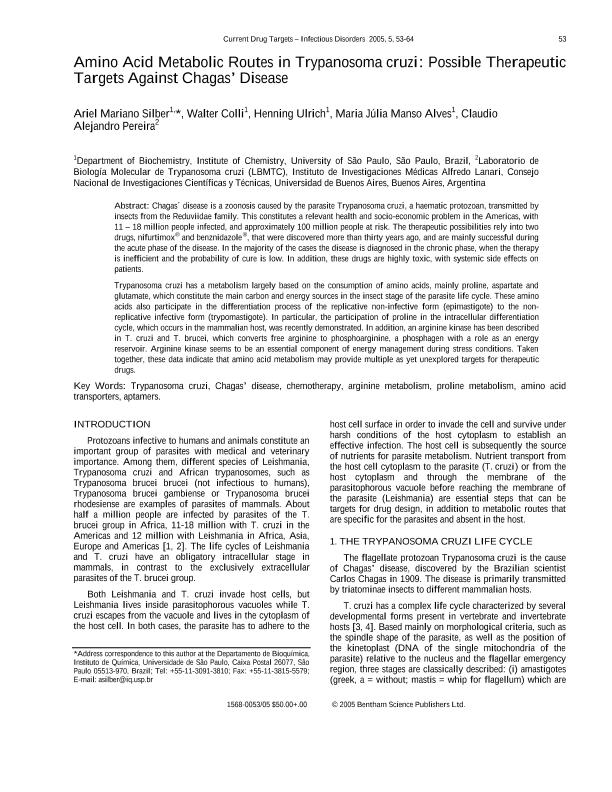Mostrar el registro sencillo del ítem
dc.contributor.author
Silber, Ariel Mariano

dc.contributor.author
Coli, Walter
dc.contributor.author
Ulrich, Henning
dc.contributor.author
Manso Alves, Maria
dc.contributor.author
Pereira, Claudio Alejandro

dc.date.available
2023-04-17T17:36:05Z
dc.date.issued
2005-12
dc.identifier.citation
Silber, Ariel Mariano; Coli, Walter; Ulrich, Henning; Manso Alves, Maria; Pereira, Claudio Alejandro; Amino acid metabolic routes in Trypanosoma cruzi: Possible therapeutic targets against Chagas' disease; Bentham Science Publishers Ltd.; Current Drug Targets - Infectious Disorders; 5; 1; 12-2005; 53-64
dc.identifier.issn
1568-0053
dc.identifier.uri
http://hdl.handle.net/11336/194228
dc.description.abstract
Chagas' disease is a zoonosis caused by the parasite Trypanosoma cruzi, a haematic protozoan, transmitted by insects from the Reduviidae family. This constitutes a relevant health and socio-economic problem in the Americas, with 11 - 18 million people infected, and approximately 100 million people at risk. The therapeutic possibilities rely into two drugs, nifurtimox® and benznidazole®, that were discovered more than thirty years ago, and are mainly successful during the acute phase of the disease. In the majority of the cases the disease is diagnosed in the chronic phase, when the therapy is inefficient and the probability of cure is low. In addition, these drugs are highly toxic, with systemic side effects on patients. Trypanosoma cruzi has a metabolism largely based on the consumption of amino acids, mainly proline, aspartate and glutamate, which constitute the main carbon and energy sources in the insect stage of the parasite life cycle. These amino acids also participate in the differentiation process of the replicative non-infective form (epimastigote) to the non-replicative infective form (trypomastigote). In particular, the participation of proline in the intracellular differentiation cycle, which occurs in the mammalian host, was recently demonstrated. In addition, an arginine kinase has been described in T. cruzi and T. brucei, which converts free arginine to phosphoarginine, a phosphagen with a role as an energy reservoir. Arginine kinase seems to be an essential component of energy management during stress conditions. Taken together, these data indicate that amino acid metabolism may provide multiple as yet unexplored targets for therapeutic drugs.
dc.format
application/pdf
dc.language.iso
eng
dc.publisher
Bentham Science Publishers Ltd.
dc.rights
info:eu-repo/semantics/openAccess
dc.rights.uri
https://creativecommons.org/licenses/by-nc-sa/2.5/ar/
dc.subject
AMINO ACID TRANSPORTERS
dc.subject
APTAMERS
dc.subject
ARGININE METABOLISM
dc.subject
CHAGAS' DISEASE
dc.subject
CHEMOTHERAPY
dc.subject
PROLINE METABOLISM
dc.subject
TRYPANOSOMA CRUZI
dc.subject.classification
Bioquímica y Biología Molecular

dc.subject.classification
Ciencias Biológicas

dc.subject.classification
CIENCIAS NATURALES Y EXACTAS

dc.title
Amino acid metabolic routes in Trypanosoma cruzi: Possible therapeutic targets against Chagas' disease
dc.type
info:eu-repo/semantics/article
dc.type
info:ar-repo/semantics/artículo
dc.type
info:eu-repo/semantics/publishedVersion
dc.date.updated
2020-07-21T20:24:24Z
dc.journal.volume
5
dc.journal.number
1
dc.journal.pagination
53-64
dc.journal.pais
Emiratos Árabes Unidos

dc.description.fil
Fil: Silber, Ariel Mariano. Universidade de Sao Paulo; Brasil
dc.description.fil
Fil: Coli, Walter. Universidade de Sao Paulo; Brasil
dc.description.fil
Fil: Ulrich, Henning. Universidade de Sao Paulo; Brasil
dc.description.fil
Fil: Manso Alves, Maria. Universidade de Sao Paulo; Brasil
dc.description.fil
Fil: Pereira, Claudio Alejandro. Universidad de Buenos Aires. Facultad de Medicina. Instituto de Investigaciones Médicas; Argentina. Consejo Nacional de Investigaciones Científicas y Técnicas; Argentina
dc.journal.title
Current Drug Targets - Infectious Disorders
dc.relation.alternativeid
info:eu-repo/semantics/altIdentifier/doi/http://dx.doi.org/10.2174/1568005053174636
dc.relation.alternativeid
info:eu-repo/semantics/altIdentifier/url/https://www.eurekaselect.com/article/35385
Archivos asociados
